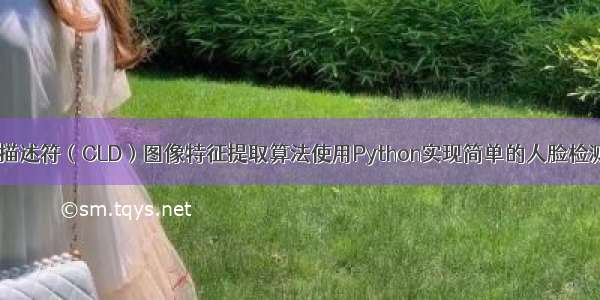
文章目录
一、环境准备二、数据集准备三、项目结构四、完整参考代码imgCode/testUI3.pyimgCode/test2.py五、运行结果测试一:测试二六、参考链接一、环境准备
需要安装:
pyqt5
pyqt5-tools
在终端中输入以下命令进行安装:
pip install -i https://pypi.tuna./simple pyqt5
pip install -i https://pypi.tuna./simple pyqt5-tools
若想实现自行设计界面及将界面转换为python文件功能,可以安装好包后参考这篇博文进行配置:
/lovesoo/p/12491361.html
二、数据集准备
实验所需数据集可从这里下载http://www.vision.caltech.edu/datasets/(需要科学上网)
下载到对应的人脸数据集后需要将图片从0-n重命名并修改代码中相关参数
若需要处理好后的数据集可私信我或从我上传的资源中下载:
数字图像处理Python+PyQt5实现基于CLD算法的人脸检测源码+数据集
三、项目结构
image_org为人脸数据集存放位置
test2为CLD及相关算法函数实现
testUI3为PyQt5实现的界面代码及图像检索功能相关代码
四、完整参考代码
imgCode/testUI3.py
# -*- coding: utf-8 -*-import cv2from PyQt5 import QtCore, QtGui, QtWidgetsfrom PyQt5.QtWidgets import QFileDialog, QApplicationimport test2 as t2class Ui_MainWindow(object):def setupUi(self, MainWindow):MainWindow.setObjectName("MainWindow")MainWindow.resize(775, 721)self.centralwidget = QtWidgets.QWidget(MainWindow)self.centralwidget.setObjectName("centralwidget")self.pushButton_openImage = QtWidgets.QPushButton(self.centralwidget)self.pushButton_openImage.setGeometry(QtCore.QRect(70, 260, 93, 28))self.pushButton_openImage.setObjectName("pushButton_openImage")self.label_image = QtWidgets.QLabel(self.centralwidget)self.label_image.setGeometry(QtCore.QRect(200, 50, 321, 231))self.label_image.setFrameShape(QtWidgets.QFrame.Box)self.label_image.setObjectName("label_image")self.label_image.setScaledContents(True) # 图片填充整个框self.pushButton_saveImage = QtWidgets.QPushButton(self.centralwidget)self.pushButton_saveImage.setGeometry(QtCore.QRect(70, 350, 93, 28))self.pushButton_saveImage.setObjectName("pushButton_saveImage")self.label_txt = QtWidgets.QLabel(self.centralwidget)self.label_txt.setGeometry(QtCore.QRect(200, 350, 321, 231))self.label_txt.setFrameShape(QtWidgets.QFrame.Box)self.label_txt.setObjectName("label_txt")self.label_txt.setScaledContents(True) # 图片填充整个框self.label_imagePath = QtWidgets.QLabel(self.centralwidget)self.label_imagePath.setGeometry(QtCore.QRect(570, 60, 150,100))self.label_imagePath.setObjectName("label_imagePath")self.label_imagePath.setWordWrap(True)MainWindow.setCentralWidget(self.centralwidget)self.menubar = QtWidgets.QMenuBar(MainWindow)self.menubar.setGeometry(QtCore.QRect(0, 0, 775, 26))self.menubar.setObjectName("menubar")MainWindow.setMenuBar(self.menubar)self.statusbar = QtWidgets.QStatusBar(MainWindow)self.statusbar.setObjectName("statusbar")MainWindow.setStatusBar(self.statusbar)self.retranslateUi(MainWindow)QtCore.QMetaObject.connectSlotsByName(MainWindow)self.pushButton_openImage.clicked.connect(self.openImage)self.pushButton_saveImage.clicked.connect(self.findImage)def retranslateUi(self, MainWindow):_translate = QtCore.QCoreApplication.translateMainWindow.setWindowTitle(_translate("MainWindow", "MainWindow"))self.pushButton_openImage.setText(_translate("MainWindow", "上传图像"))self.label_image.setText(_translate("MainWindow", "待检索图像"))self.pushButton_saveImage.setText(_translate("MainWindow", "开始检索"))# self.pushButton_openFile.setText(_translate("MainWindow", "打开文件"))self.label_txt.setText(_translate("MainWindow", "检索到的图片(若找不到,显示“查无此人”)"))self.label_imagePath.setText(_translate("MainWindow", "图片路径"))def openImage(self): # 选择本地图片上传global imgName # 这里为了方便别的地方引用图片路径,我们把它设置为全局变量imgName, imgType = QFileDialog.getOpenFileName(self.centralwidget, "打开图片", "", "*.jpg;;*.png;;All Files(*)") # 弹出一个文件选择框,第一个返回值imgName记录选中的文件路径+文件名,第二个返回值imgType记录文件的类型jpg = QtGui.QPixmap(imgName).scaled(self.label_image.width(), self.label_image.height()) # 通过文件路径获取图片文件,并设置图片长宽为label控件的长宽self.label_image.setPixmap(jpg) # 在label控件上显示选择的图片self.label_imagePath.setText(imgName) # 显示所选图片的本地路径def findImage(self):img = cv2.imread(imgName) # 这里就是读取0.jpgimg = cv2.resize(img, (256, 384))CLD_img1 = t2.CLD(img) # 对img进行CLD处理cld_index = []cld_img = []cld_class = []cld_new_class = []# {坐标:距离}dict = {}for i in range(0, 432):img2 = cv2.imread('.\\image_org\\faces\\%d.jpg' % (i))img2 = cv2.resize(img2, (256, 384))CLD_img2 = t2.CLD(img2)distances = t2.distance_CLD(CLD_img1, CLD_img2)dict[i] = distancesdict_sorted = sorted(dict.items(), key=lambda kv: (kv[1], kv[0]))print(dict_sorted)print(type(dict_sorted)) # listprint(dict_sorted[0][0])print(type(dict_sorted[0][0]))img_out_index = str(dict_sorted[0][0])if dict_sorted[0][1] >= 1200:print("查无此人")self.label_txt.setText("查无此人")else:img_path = './image_org/faces/' + img_out_index + '.jpg'jpg = QtGui.QPixmap(img_path).scaled(self.label_image.width(),self.label_image.height()) # 通过文件路径获取图片文件,并设置图片长宽为label控件的长宽self.label_txt.setPixmap(jpg)# def saveImage(self): # 保存图片到本地#screen = QApplication.primaryScreen()#pix = screen.grabWindow(self.label_image.winId())#fd,type= QFileDialog.getSaveFileName(self.centralwidget, "保存图片", "", "*.jpg;;*.png;;All Files(*)")#print(fd)## pix.save(fd)# def openDirectory(self): # 打开文件夹(目录)#fd = QFileDialog.getExistingDirectory(self.centralwidget, "选择文件夹", "")#self.label_directoryPath.setText(fd)# def openTextFile(self): # 选择文本文件上传#fd,fp = QFileDialog.getOpenFileName(self.centralwidget, "选择文件", "", "*.txt;;All Files(*)")#f=open(fd,'r')#self.label_txt.setText(f.read())#self.label_filePath.setText(fd)#f.close()# def saveTextFile(self): # 保存文本文件#fd,fp= QFileDialog.getSaveFileName(self.centralwidget, "保存文件", "", "*.txt;;All Files(*)")#f=open(fd,'w')#f.write(self.label_txt.text())#f.close()if __name__ == "__main__":import sysapp = QtWidgets.QApplication(sys.argv)formObj = QtWidgets.QMainWindow()ui = Ui_MainWindow()ui.setupUi(formObj)formObj.show()sys.exit(app.exec_())
imgCode/test2.py
# coding: utf-8# In[1]:import cv2import numpy as npimport matplotlib.pyplot as pltimport pandas as pdfrom scipy.fftpack import dctimport redis# In[2]:def cvshow(name, img):cv2.imshow(name, img)cv2.waitKey(0)cv2.destroyAllWindows()# In[3]:def CLD(img):# 图像分割8*8n = 8(height, width, channel) = img.shape# print(height,width,channel) #384 256 3block_h = np.fix(height / n) # 每块的高度block_w = np.fix(width / n) # 每块的宽度# print(block_h,block_w) # 48.0 32.0im_n = np.zeros((n, n, channel))for i in range(n):for j in range(n):for k in range(channel):# 确定块a = block_h * i + 1b = block_h * (i + 1) # height: b-ac = block_w * j + 1d = block_w * (j + 1) # width: d-c# 循环到右下角的块时if i == (n - 1):b = height - 1if j == (n - 1):d = width - 1# 每块代表色的选择,实现“mpeg-7标准推荐使用区域块的平均像素颜色值作为代表颜色”# print(img[int(a)][int(d)][int(k)])arr = [img[int(a)][int(c)][k], img[int(a)][int(d)][k], img[int(b)][int(c)][k], img[int(b)][int(d)][k]]pix = np.mean(np.mean(arr));# print(pix)im_n[i][j][k] = pix# print(im_n)# 将rgb转换色彩空间为YCbCrmat = np.array([[65.481, 128.553, 24.966],[-37.797, -74.203, 112.0],[112.0, -93.786, -18.214]])offset = np.array([16, 128, 128])# rgb2ycbcr():颜色空间转换的函数im_YCbCr = rgb2ycbcr(mat, offset, im_n)# DCT变换im_DCT = np.zeros((n, n, channel));# 因为dct操作只能对二维矩阵进行操作,所以这里要把r,g,b分别拎出来处理im_DCT[:, :, 0] = dct(im_YCbCr[:, :, 0])im_DCT[:, :, 1] = dct(im_YCbCr[:, :, 1])im_DCT[:, :, 2] = dct(im_YCbCr[:, :, 2])# print(im_DCT)# 按照之字形扫描im_DCT存储到descript中zig = [[0, 1, 5, 6, 14, 15, 27, 28],[2, 4, 7, 13, 16, 26, 29, 42],[3, 8, 12, 17, 25, 30, 41, 43],[9, 11, 18, 24, 31, 40, 44, 53],[10, 19, 23, 32, 39, 45, 52, 54],[20, 22, 33, 38, 46, 51, 55, 60],[21, 34, 37, 47, 50, 56, 59, 61],[35, 36, 48, 49, 57, 58, 62, 63]]descript = np.zeros((n * n, channel));for i in range(n):for j in range(n):descript[zig[i][j], :] = im_DCT[i, j, :];# print(descript);result = descript;return result;# In[4]:# 颜色空间转换的函数def rgb2ycbcr(mat, offset, rgb_img):n = 8channel = 3ycbcr_img = np.zeros((n, n, channel))for x in range(n):for y in range(n):ycbcr_img[x, y, :] = np.round(np.dot(mat, rgb_img[x, y, :] * 1.0 / 255) + offset)return ycbcr_img# In[5]:def distance_CLD(img1, img2):return np.sqrt(np.sum(np.square(img1 - img2))) # 欧式距离# In[6]:def drawline(recall, precision):plt.plot(recall, precision)plt.xlabel("recall")plt.ylabel("precision")plt.title('PR Graph of CLD')plt.show()# In[7]:if __name__ == "__main__":img_index = 60; # 设置样本img的编号img = cv2.imread('./image_org/faces/' + str(img_index) + '.jpg') # 这里就是读取0.jpgCLD_img1 = CLD(img) # 对img进行CLD处理cld_index = []cld_img = []cld_class = []cld_new_class = []# {坐标:距离}dict = {}for i in range(0, 432):img2 = cv2.imread('.\\image_org\\faces\\%d.jpg' % (i))img2 = cv2.resize(img2, (256, 384))CLD_img2 = CLD(img2)distances = distance_CLD(CLD_img1, CLD_img2)dict[i] = distancesdict_sorted = sorted(dict.items(), key=lambda kv: (kv[1], kv[0]))print(dict_sorted)print(type(dict_sorted)) # listprint(dict_sorted[0][0])print(type(dict_sorted[0][0]))img_out_index = str(dict_sorted[0][0])if dict_sorted[0][1]>=1200:print("查无此人")else:img_out = cv2.imread('./image_org/faces/' + img_out_index + '.jpg')cvshow("img",img_out)
五、运行结果
测试一:
描述:上传一张存在于数据库中的人物的图像(上传的图片在数据库中没有完全相同的对应图像,只有与其相似的数张图像),检索后返回一张与上传图片最像(两者“距离”最小)的图片,表示在数据库中成功检索到该人物
样例一:
上传图片后界面显示:
点击“开始检索”后界面:
可以看到成功检索到了该人物
样例二:
样例三:
可以看到都成功检索到了对应人物的图像
测试二
描述:上传一张不存在于数据库中的人物的图像,检索后若找不到则会显示“查无此人”,表示在数据库中检索不到该人物(本程序中阈值设置为1200,即通过计算后上传的图片与数据库中图片的最小距离若大于 1200,则认为该上传图像对应的人物不存在于数据库中,显示“查无此人”)
样例一:
上传图片后界面:
点击“开始检索”后界面:
可以看到在数据集中检索不到该人物,从控制台中输出可以看到上传的该图像与数据集中图像间最小“距离”大于阈值1200,因此判定为“检索不到”,显示“查无此人”
样例二:
六、参考链接
PyQt5环境搭建与基本使用
pyqt5:利用QFileDialog从本地选择图片\文本文档显示到label、保存图片\label文本到本地(附代码)
图像特征提取算法:颜色布局描述符Color Layout Descriptor
数据集下载
计算机视觉 实验四 分别使用颜色布局描述符(Color Layout Descriptor)与方向梯度直方图(HOG)实现图像检索,并且画出图像的PR曲线图
本文章相关源代码与处理好的人脸数据集:数字图像处理Python+PyQt5实现基于CLD算法的人脸检测源码+数据集
基于颜色布局描述符(CLD)图像特征提取算法使用Python实现简单的人脸检测功能并使用PyQt5构建简单的功能界面(数字图像处理课程实验)
如果觉得《基于颜色布局描述符(CLD)图像特征提取算法使用Python实现简单的人脸检测功能并使用P》对你有帮助,请点赞、收藏,并留下你的观点哦!














